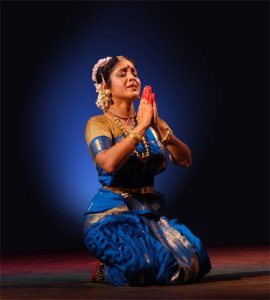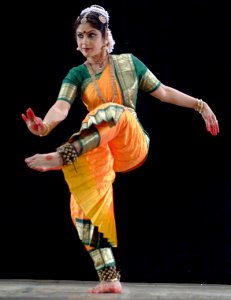
Pure Ananda
- Vanitha
Veeravalli, Chicago
July 11, 2007
This summer saw
several artistes from India present their productions at various venues
in the US. Among the memorable ones was Ananda Shankar Jayanth's presentation
of Tyagaraja Ramayana and Gitopadesa. This was noteworthy
for several reasons. At a time when group productions catch audience fancy,
creating sustained audience interest through solo performance is a challenge.
Ananda stepped up to that with notable creativity and maturity through
two of her well-planned and executed productions that were as much a lesson
in story telling, as was a brisk performance.
 |
 |
Tyagaraja Ramayana
is an ekaharya or a solo-act, wherein the story of Rama, was told in two
parts - from Rama's birth to Sita Kalyanam and from Bharata's search for
Rama to his final coronation in Ayodhya – through the kritis of Tyagaraja,
and verses of Valmiki. In this, Ananda's depiction brimmed with such eloquence
and energy that it painted beautiful visuals. When Ravana tries to lift
the bow, but fails miserably and sneaks away trying to hide his face, this
was depicted with perceptible humor and good audience reaction. Sita Kalyanam,
where Sita bashfully follows Rama, her hand held in his, as they do the
saptapadi was done with great sensitivity. The following oonjal scene,
where Sita, perched on the other end of the swing modestly, holds on to
the chain, and sneaks a few glances at him, was as memorable for its visual
poetry as was Tyagaraja's kriti. (In fact it was hard to reconcile that
there was no swing there after all, when Ananda was done!). Vali's lamentation
to Sri Rama, Marugelara, as he pleads for moksha was absolutely
moving for the pathos Ananda brought to the scene through controlled display
of expressions. Such scenes were happily many. The ability to cleanly delineate
the characters through abhinaya and nritta, so critical to the enjoyment
of a solo-act, was clearly evident in her style. Ananda's key strength
was the ability to underscore each of these highly descriptive situations
with creative nuances that make the depiction not just more eloquent, but
very memorable.
The other salient
piece of the program showed the battlefront scene in Mahabharata, when
Arjuna despairs at the prospect of having to fight his near and dear, and
prepares to relinquish arms. Krishna’s advice, Gitopadesa, was the
subject of this ekaharya in which the essence of the Bhagavad Geeta was
portrayed. The performance was about the dialog between Krishna and Arjuna,
where Krishna chides him and teaches him the Supreme truth about Dharma
and Karma. Arjuna realizing that Sri Krishna is the Supreme being requests
and witnesses His Viswaroopa. The self-assuredness of Krishna and the self-doubt
of Arjuna provided contrasts of character development that Ananda brought
out to great enjoyment. In fact, a subject matter such as this can be concept-heavy,
but Ananda struck the right balance at visual story telling. Ananda's tireless
performance was greatly aided by the team of musicians – Venu Madhav (vocal),
Balasubramaniam (mridangam), Renukaprasad (nattuvangam), and Sai Kumar
(violin) - who showed such obvious togetherness, that you knew the production
was well-baked to perfection.
All in all,
it was pure Ananda.
Vanitha
Veeravalli was a student of Kalakshetra, and later studied with other teachers.
|

